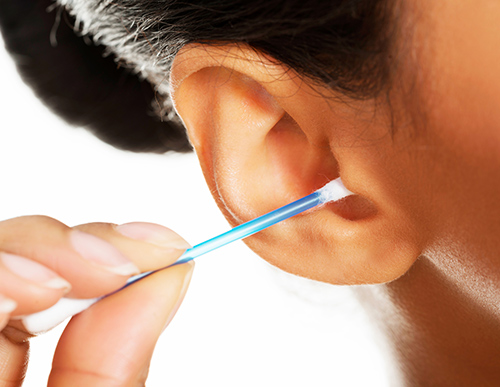
Have you ever noticed the warning on your box of swabs? Look on the side and you might see something like this: “WARNING: Do not insert swab into ear canal.” And yet, how many of us ignore this warning or have never noticed it? It’s time to take your grandma, your hearing care professional, the American Academy of Otolaryngology-Head and Neck Surgery (AAO-HNS) and your box of swabs seriously: Stop cleaning your ears with swabs (or anything else smaller than your elbow). Here’s 5 reasons why:
1. Your Ears are Self Cleaners
That icky, sticky-looking ear wax (“cerumen” is the medical word) actually cleans your ears. So leave it in there. It grabs and traps stray dust and dirt, preventing it from getting deeper into your ear canal. Then, as you go through your day talking, chewing and yawning, those actions actually move the soiled ear wax down and out of the ear canal where you can easily wipe it out with a washcloth during your shower. So easy, right? Way to go, ear wax!
What this basically means is that whenever you stick a finger, swab, key, fork, pencil, chopstick, etc. into your ear to dig out what you think is unnecessary ear wax, you’re actually thwarting your ears own self-cleaning process, shoving cerumen back down into the ear canal where it might get impacted and cause hearing loss—or injury from sticking things into your ears that you shouldn’t.
2. Ear Wax has Loads of Health Benefits for Your Ears
Sure, most of us shudder at the thought of noshing an ear wax flavored Bertie Bott’s Every Flavor jellybean, but cerumen actually has loads of health properties that help keep your ears healthy. Cerumen is produced by special glands inside of your ear canal, and it’s a special concoction consisting of long-chain fatty acids, alcohols, enzymes, cholesterol, sebum, sloughed off skin cells and other chemicals that perform a wide range of ear-protecting functions like:
- It’s antimicrobial; it protects your ears against viral, fungal and bacterial infections very effectively.
- It repels insects—their sensitive sense of smell finds ear wax too stinky.
- It lubricates and moisturizes the ear canal, keeping it healthy and soft.
- Healthy ear wax is slightly acidic, something else that hinders fungal and bacterial growth in your ears.
See? Ear wax is pretty awesome stuff!
3. Ear Wax Removal: It Dulls Hearing
You may already have sustained some level of hearing loss, just from the process of swab-based ear wax removal habits. This type of ear wax removal actually shoves soiled, old ear wax further down into the ear canal where it can become impacted and cause hearing loss. If you’ve been doing this for years, schedule an appointment with your hearing care professional to have them check whether you have impacted ear wax that might be causing some amount of hearing loss.
Now, you may be one of those people who actually do have a problem with ear wax (beyond just wanting it gone). Some people make too much, while others don’t make enough. Occasionally, it may be too wet, too dry or not have the right balance of ingredients to get the job done right. Nevertheless, you still shouldn’t try to remedy or clean it out yourself with a swab or anything else (smaller than your elbow). If you’re worried about the health of your ear wax, please get in touch with your hearing care professional for an evaluation.
Now, if you need to wear hearing aids, you do need to pay attention to ear wax buildup and proper ear cleaning because sometimes that can impact ear wax into the ear canal. But still—no swabs! That’s why it’s so important to follow your hearing care professional’s recommendations on gentle ear washing and regular cleaning of your hearing aids to keep the balance right and your hearing healthy.
4. Ear Cleaning: Accidents Happen
And they happen all too often. About 12,500 kids all across America end up in the doctor’s office each year with ear cleaning injuries like torn tympanic membrane (ear drum) or cuts and lacerations inside the ear canal. Unfortunately, these accidents can cause hearing loss, particularly during a developmentally important time in life. Aggressive ear cleaning with pointy objects is something the whole family could do without.
And don’t get us started on “ear candling”. Thousands of people sustain “ear candling” injuries every year, which is very unfortunate. Often advertised at your local health food store as a “natural ear wax removal” technique, ear candling enthusiasts stick a hollow, cone-shaped candle into their ear canals and set it on fire. Who thought that was a good idea? Just because it’s billed as “ancient” and “natural” doesn’t mean it’s actually good. Here’s what you need to know about ear candles:
- It’s been proven ineffective for ear cleaning and can actually make ear wax impaction worse.
- It causes burn injuries to the face, ears, hair, etc. – even burns that go all the way to the ear drum and middle ear.
- It’s also been known to puncture the ear drum.
So no ear candling for you!
5. The Safest Way to Clean Your Ears Is…
While you’re in the shower, use your washcloth to gently wipe around your ears, taking care not to stick your finger into the ear canal. Then just towel away the excess water when you’re done and voila! Ears sufficiently cleaned. But if you have any concerns about your ear health, excess ear wax, impaction, ear injury or hearing loss, schedule an appointment with your hearing care professional today for appropriate care – and be a little more thankful for that hard-working cerumen!